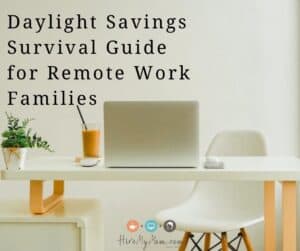Daylight Savings Survival Guide for Remote Work Families

The transition between being on/off Daylight Savings Time (DST) is something that many people have come to dread. The time change disrupts sleep patterns, leading to cranky babies and exhausted parents. For those who work from home, working through these adjustments can be especially challenging as you balance professional responsibilities with the needs of your little ones.
The Impact of Daylight Savings on Young Children
Daylight Savings can be particularly tough on young children, as babies and toddlers thrive on routine. A sudden change in their sleep schedule can throw them off balance, leading to increased fussiness, shorter naps, and restless nights. Children under five are especially sensitive to time changes since their internal clocks are still developing. The loss of an hour in springtime often means waking up earlier than their bodies are used to, resulting in overtired kids who may resist naps or bedtime. This disruption impacts not only their well-being but also yours as a parent working from home.
Gradually Adjusting Sleep Schedules Before the Time Change
To lessen the impact of Daylight Savings, start shifting your child’s sleep schedule in small increments several days before the time change. Adjust bedtime and wake-up times by 10-15 minutes each day until you achieve the desired schedule. For instance, if bedtime is usually 7:00 PM, move it to 6:45 PM for a few nights, then to 6:30 PM, and so on. This gradual shift allows your child’s internal clock to adjust smoothly, minimizing disruption.
While making these changes, keep the bedtime routine consistent — stick to familiar activities like reading a book or singing a lullaby to signal that it’s time to wind down. Using blackout curtains and a white noise machine can also create an environment conducive to sleep, helping ease the transition. This method ensures your child’s body gradually acclimates to the new schedule, reducing the likelihood of overtiredness and crankiness.
Creating a Consistent Daily Routine for Better Adjustment
Maintaining a consistent daily routine is essential for helping young children adapt to the time change. Structure your day with regular intervals for meals, naps, and playtime to provide stability and predictability. Sync your work tasks around your child’s routine, blocking out focused work periods during their naps or after bedtime. This approach not only ensures you remain productive but also allows you to be present during your child’s waking hours. Use visual schedules to help your child understand the new routine and keep activities consistent to create a comforting environment. Predictability helps children feel secure, which eases the transition during Daylight Savings.
Balancing Remote Work and Childcare During the Transition Period
Clear communication with your employer or employees about your situation can pave the way for accommodations such as flexible work hours. Early mornings or late evenings might offer uninterrupted work time while your child sleeps. If you have a partner, coordinating childcare duties can alleviate stress and ensure both parents share the load during critical work tasks.
Engage your child in quiet, independent activities during work calls or important tasks. A “busy box” filled with coloring books, puzzles, or educational games can keep them occupied and minimize interruptions. Additionally, planning your most focused work periods around your child’s nap times or after bedtime can enhance productivity.
Self-Care Tips for Parents Navigating Daylight Savings
Balancing the demands of remote work and caring for young children during the transition of Daylight Savings can be overwhelming. It’s crucial to carve out time for self-care to maintain your physical and mental well-being. Here are some practical tips to help you navigate this period more smoothly:
- Prioritize Sleep: While adjusting your child’s schedule, ensure you’re also getting adequate rest. If possible, align your bedtime with your child’s to maximize sleep. Short naps during the day can help you recharge and stay alert.
- Mindfulness and Relaxation: Integrate mindfulness practices such as meditation, deep-breathing exercises, or stretching into your daily routine. Even a few minutes can help reduce stress and improve your focus and resilience.
- Healthy Nutrition: Eating balanced meals and staying hydrated can significantly impact your energy levels and mood. Avoid excessive caffeine and opt for nourishing snacks to sustain you throughout the day.
- Physical Activity: Incorporate some form of physical exercise into your daily routine. Whether it’s a short walk, stretching, or a quick workout, physical activity can boost your mood and energy levels.
- Connect with Others: Build a support network with other parents, family, or friends. Sharing experiences and tips can provide emotional support and practical advice.
- Flexible Expectations: Be kind to yourself and adjust your expectations. It’s okay if everything isn’t perfect. Focus on what you can control and be patient with the process.
By prioritizing your own well-being, you’ll be better equipped to manage the challenges of Daylight Savings and maintain a harmonious balance between remote work and family life.
What tips do you have for those with younger kids that struggle with the time adjustment? We would love to hear them!

